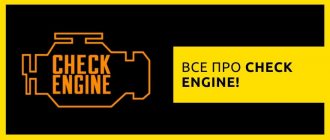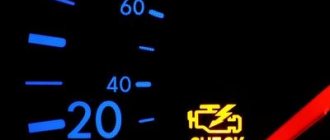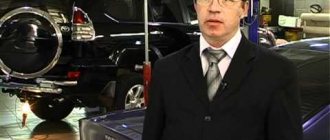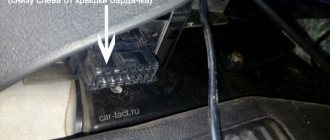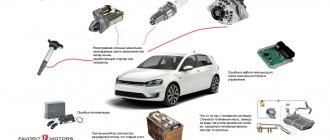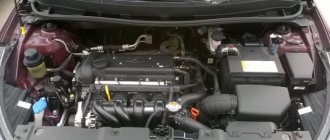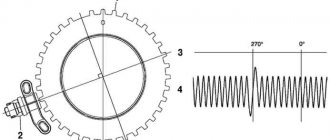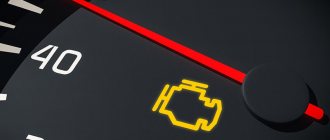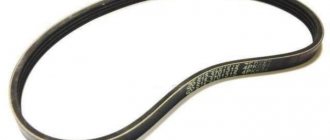Modern cars are equipped with electronic controls for monitoring and self-diagnosis of the power unit (ECM). This allows the driver to promptly learn about problems arising in the operation of the engine and take action. This is indicated by the check light on the car panel with a picture of the engine. With the appearance of this indication, it is necessary to find a reliable car service to perform engine diagnostics. This is due to the fact that the self-diagnosis system, having determined that the engine is not operating correctly, sends an error code to the on-board computer, which can be deciphered by connecting special diagnostic equipment to the electronic control.
Some modern cars, when the check light comes on, independently decipher the error code and inform the driver about the problem without the help of car service specialists. But in most cases, this function is missing, and the driver has to contact the service to understand what measures need to be taken in relation to the power unit and its secondary systems or try to fix everything themselves. But first you need to figure out why the check engine light comes on, since this indication can work in very unusual situations. There are many complaints on forums on the Internet that the check light periodically lights up, regardless of the engine temperature, when filling with fuel of questionable quality, and even after a banal wash. This begs the question: what is a check in a car and what exactly does it mean?
What does check engine mean?
All parts of the engine and its auxiliary systems operate synchronously, and the deviation of one of the systems from the required parameters affects the operation of others. In this case, the engine can operate in the same mode, and the driver will not notice any deterioration until other systems also begin to deviate from the parameters. Therefore, if the ECM detects a change in parameters, the engine icon on the control panel lights up. This does not mean that the situation is critical, since this indication is the first signal intended to prevent serious problems. But you shouldn’t use the car for a long time if you don’t know why the check light might be on. It is worth mentioning right away that this indication is always active when the ignition is turned on. Many people do not know this and are wary, believing that the self-diagnosis system identifies problems that arise during startup. But in fact, this is just a signal to the driver that the self-diagnosis system is working properly, and therefore, if the check engine light comes on in a running car, then this is normal. Once started, this alarm light will go out.
Let's take a closer look at what a check in a car is and what it means. As mentioned above, the ECM monitors almost all engine systems, and therefore there can be many reasons for the appearance of this indication. When the check engine light found its way into cars, it was designed as a simple indicator to indicate problems with the engine. This is explained by the primitiveness of the self-diagnosis system at that time. In modern cars, the ECM is capable of detecting problems related not only to the engine, but also to the ignition or fuel system. Let's consider each of them separately.
Fuel quality
As a rule, if the check light comes on after visiting a gas station, then the problem should be looked for in the fuel. An experienced driver is able to understand this himself by assessing the decrease in engine power, and after long-term use of the car, record that fuel consumption has increased. This occurs due to a mismatch in the octane number of the fuel. The self-diagnosis system detects detonation in the combustion chambers and other combustion disorders of the combustible mixture. Further, after these violations are detected, everything happens like this: a signal about them is sent to the electronic control unit - and the engine icon lights up.
The problem will disappear if you replace the fuel or, at your own risk, wait until it is completely used up and refuel with high-quality fuel. In some cases, it is even recommended to flush the fuel system, since the indication may not disappear after replacing the fuel. However, you can do without this if you reset the check engine error. To do this, you need a diagnostic device, which is available only in a car service center, or performing an independent reset, which consists of a certain sequence of actions.
Engine overheating
If the check engine blinks constantly while the power unit is running, then you should look at the temperature sensor readings. If it is above 90 °C, then the indication is working due to engine overheating. To resolve this issue, you must perform cooling system maintenance. In particular, check it for leaks and add antifreeze if its level has dropped. If after this the engine light is still on, you need to check the functionality of the thermostat and pump. In the first case, the breakdown prevents the antifreeze from circulating a full circle and the engine overheats. In the second case, the circulation of coolant is disrupted due to a breakdown of the pump or its unstable operation. When the engine temperature reaches the optimum level, the warning light will go out.
Low oil level
Another option for what to do if the check engine light is on is to check the oil level. The ECM even allows you to determine the critical oil level and send a corresponding signal to the ECU. This function is very convenient for those who rarely check the lubricant level. Thus, if everything is stable with temperature and power, but the check engine light is on, what does this mean? It's simple - the power unit has a low level of lubrication. To correct the error, the lubricant must be replenished.
Mechanical damage
If the check light comes on in the car at the same time as an extraneous knocking noise in the engine, then this is a serious problem that requires diagnosis and repair in a car service center. With this combination, it is recommended to stop moving independently and call a tow truck. A problem may arise due to the destruction of motor components due to wear or an increase in the gaps between them greater than the maximum permissible. If after service at a car service center the check engine light is still on, then specialists will reset this error.
Troubles the engine
Another problem when the check light comes on is the engine stalling. This occurs due to malfunctions associated with the ignition system or incorrect fuel supply. In the first case, it is necessary to check the high-voltage coil, the integrity of the wires and inspect the spark plugs. Fuel problems are when fuel is not supplied correctly to the cylinder or is not supplied at all. The self-diagnosis system monitors these symptoms and sends an error code to the ECU. This is why the check engine light comes on when the engine stalls.
The mass air flow sensor has failed
The element may have failed due to being covered with dust. But this is not the main reason for his loss of performance. There may simply be deviations in the readings. To eliminate this reason, it is necessary to clean the sensor with a special liquid.
It should be remembered that using carburetor cleaner as this product can cause irreparable damage to the sensor. If the oxygen sensor completely fails, it must be replaced.
Why does the check engine light come on when cold?
Many people are surprised that the check light is on in a car with a still cold engine. But, as stated above, the self-diagnosis system begins to work when the engine starts. Despite the fact that monitoring of some systems is possible only when the power unit reaches the optimal temperature, the ECM can detect violations even in a cold engine. Let's look at them in detail:
- The check engine indicator works when the spark plugs are dirty or completely out of order. Consequently, the combustible mixture does not ignite in the cylinder, and this violation is recorded by the ECM.
- Violation of the insulation of high-voltage wires or oxidation of the contact group also prevents the generation of a spark and, as a result, the cylinder does not work.
- An incorrectly functioning high-voltage coil may cause the check light to light up on the instrument panel. This happens when the resistance at the terminals does not meet the required parameters.
- Low throughput of fuel injection devices. Due to a dirty injector or nozzle, the full volume of the combustible mixture enters the combustion chambers late and does not have time to burn completely.
- Low fuel pressure. Caused by a breakdown of the fuel pump or contamination of the filtration element.
- A breakdown of the oxygen sensor or catalyst causes the check engine error to appear. Depending on the type of failure, these parts can be repaired or replaced so that the error disappears.
Do not forget that self-diagnosis is an independent system. Consequently, it may also not work correctly due to the breakdown of some of its components. In particular, if one of the system sensors malfunctions, the check light in the car will light up. To check the correct operation of engine self-diagnosis, diagnostics are required using special devices in a car service center.
Communication with cars
As with most problems with personal transport, you need to be able to listen to it. Modern vehicles are equipped with “brains” and interactive dashboards to “talk” to you, but it’s also wise to pay attention to the “classical language”: knocks, vibrations, hums, loss of power and much more. We looked at the most “popular” answers to the question why the check engine light is on. We hope this helps. Good luck on the roads! In any incomprehensible situation, go to the online platform for selecting car services Uremont.com to leave a request for service or consult a master consultant for free by ordering a call.
How to reset check engine
It is not always necessary to contact a car service to perform a reset. Only in cases where it is impossible to eliminate the violation yourself. If the cause has been eliminated, but the engine error remains on, to remove it you must do the following:
- bring the engine to operating temperature;
- disconnect the plus from the battery for about 15 minutes and connect again;
- turn the ignition key to the penultimate position so that the lights on the control panel become active;
- After a minute, return the ignition key to its original position.
After this sequence of actions, you can start the engine to make sure that the check light is not on. But this is provided that the violations have been eliminated and the incorrectly operating systems are functioning again according to the required parameters.
Unfortunately, this method does not always help when the check light comes on, the reasons are that it is of a different nature. The most reliable way to remove the error is through software intervention. For this purpose, cars manufactured since 2000 have a special OBD2 connector for connecting diagnostic equipment. This connector may be located under the steering column, near the pedal assembly, or in other areas around the steering wheel, depending on the car model. The connector is standard and therefore the same on all cars, but the diagnostic equipment is different. Therefore, you may need a special adapter to synchronize diagnostic tools to the OBD2 connector. After a soft reset, the check engine light will go out.
How safe is it to drive with Check Engine?
It all depends on how serious the problem is in the car. This may not be something as catastrophic as a low battery voltage, but it could be a more serious problem that could cause more damage to your vehicle. In the worst case scenario, the car may stall or lose control. We recommend having your car checked as soon as possible to be on the safe side. If the Check Engine blinks repeatedly, it means that the onboard computer has detected a problem that some of the engine's cylinders are not firing properly. Driving with an engine misfire can damage the catalytic converter, which is very costly. I strongly recommend contacting an authorized dealer.
What to do when the check light is on in the car: conclusions
Above, we examined what a check engine is and identified the reasons why this indication starts to work. It is important to remember that the operation of the indication coincides with the incorrect behavior of the motor, which can often be felt without diagnostic devices. By comparing changes in the operation of the power unit with the check engine indication, you can independently determine where to look for malfunctions: cooling system, oil level, fuel supply or ignition problems.
It should also be said about the vulnerability of not only the self-diagnosis system. The ECU may also not work correctly, making errors when receiving information about the state of the engine. Therefore, it may also be the reason why the check engine light came on. Only specialists can cope with such a problem, because the reason for poor functioning of the ECU can be associated with both hardware damage and firmware.
To avoid this indication after the engine is started, you should regularly monitor the performance of the cooling system and prevent the oil level from decreasing. Also, you should not allow the spark plugs to become dirty, and you should not allow yourself to skimp on the quality of fuel. Attempts to save on consumables often result in serious technical problems for the car, and the check engine warning light will always remind you of this, irritating the driver. At every car maintenance, it is recommended to diagnose the ECU to ensure correct operation.
Scan the on-board computer to check engine codes.
A service technician at an authorized dealer uses a diagnostic tool.
If your car is fairly new, it makes sense to take it to the dealer since repairs may be covered under warranty. Specialists who are familiar with common problems in these cars provide good technical support. They have special test equipment designed for your car, and they also have original spare parts in stock. On the other hand, repairs at dealerships tend to be very expensive. Independent, or simply conventional, repair shops are usually not so expensive, but a lot depends on the professional level of training of specialists, the availability of their own testing equipment, the latest information and service parts quality. Another popular option is to take your car to an independent mechanic who specializes in your car's brand. This is especially common for German and other European cars, as they have more complex electronics compared to other European companies. Of course, there is always the option of doing it yourself. If you have enough knowledge and the necessary tools, then such repairs are within your power. Not all problems can be self-diagnosed, but that doesn't mean it's not worth trying.
Catalyst failure
If the catalyst fails, you will in no way be able to fully drive the car, since the engine will operate unstable, as evidenced by the “Check” button. In this case, your car will experience significant fuel consumption and there will be no traction. In this case, preventive and repair measures will not help. The equipment needs replacement. Yes, a catalyst is a rather expensive thing, but if it is the problem, the deficiency will completely eliminate itself.
Clogged injectors
Without this consumable, it will not be possible to ensure uniform fuel supply to the engine, and they fail with enviable regularity.
Periodic cleaning or replacement of injectors must be carried out every 20-3 thousand kilometers, and even more often when using bad fuel.
In a car service, the procedure is carried out using ultrasound. If this does not help and a new part needs to be installed, the assembly and disassembly operation will be much more difficult.
It is important to note: In modern foreign cars, clogged injectors can be diagnosed independently, using the on-board computer. If a problem is detected, you can move to the service center under your own power, but at low speeds.
Say no to panic
If you notice the “Check” button is lit, do not panic. This will not help eliminate the shortcomings. Get yourself together and first try to correct the shortcomings yourself according to the recommendations given in our article, and only then look for the reasons more deeply.
If the above tips did not help you, and you still cannot decide why the “Check” light comes on, you should seek help from professionals. You don't need to invent anything on your own. Today's service stations are equipped with the most high-tech and modern equipment that will help find a solution to this issue. Of course, you may have to spend a certain amount of money. But it's not the end of the world. The main thing is to find the reason, since your safety on the road depends on it.
If the Check engine indicator light comes on on the dashboard of your car (or simply the “check” is on), you should at least be wary. The reasons for this can be very diverse - from a loose gas tank cap to serious problems with the engine.
Recommendations for checking high-voltage wires
High-voltage wires are another reason when the “Check” lights up. To check it, you must follow the recommendations below. To check the high-voltage wires yourself, follow the steps below:
- Fill a stainless steel container with water and add a tablespoon of baking soda.
- Dip the wires into the solution, leaving the ends on the surface. Next, start checking the wires using a megger. Connect the device itself to the first tip, and the other wire must be connected to a container with wires. If an insulation fault is detected, the resistance will be less than 500 kOhm. In this case, the wires require replacement.
ECU failures
Let's assume that it was not possible to find the faults listed above, but the unpleasant sign on the panel continues to burn. In this case, look at the adequacy of the ECU operation. The electronic control unit is the brain of the car.
It communicates with all key nodes, sensors and sensors, but in rare situations it can fail. In this case, the engine error will light up without objective reasons.
To get rid of it, the car must be completely de-energized, including turning off the alarm. Disconnect the terminal for about 20-30 seconds, and then evaluate the result.
Important to note: Sometimes the board or firmware in the ECU has to be changed. In this case, you will need the help of an expert.
Oil level drop
An error in engine operation can also occur due to something as trivial as a lack of lubrication. Usually this option is built into expensive foreign cars and is almost always accompanied by another icon - overheating.
Moreover, they do not light up immediately after ignition, but only after a few minutes. Check the amount of oil fluid with a dipstick and, if necessary, add it to eliminate the error yourself.
It is important to note: If the situation repeats with a small frequency, you will still have to call the master. Because oil consumption can be a symptom of other “diseases” of the engine or car.
